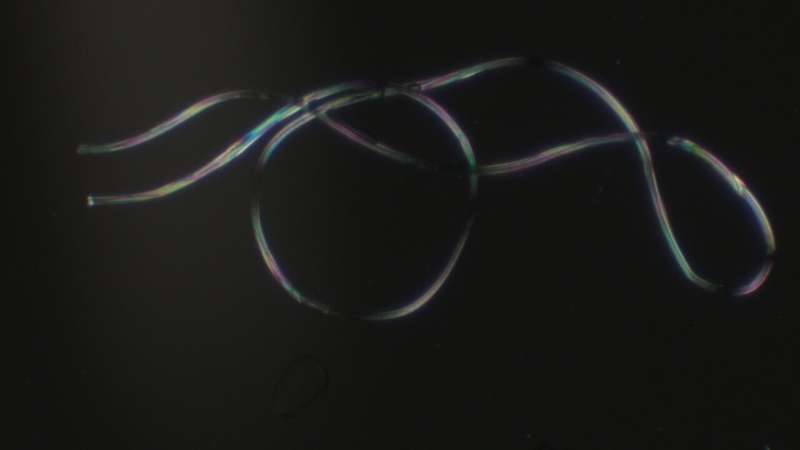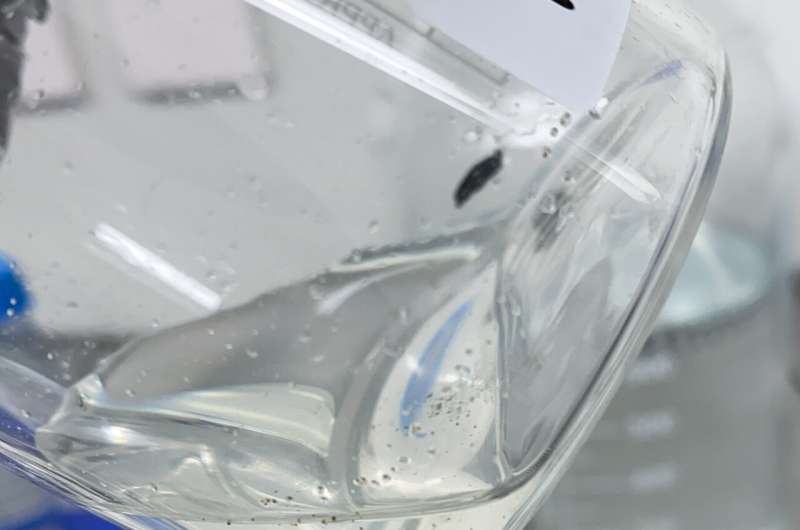Synthetic fibers discovered in Antarctic air, seawater, sediment and sea ice

As nations meet in Uruguay to negotiate a new Global Plastics Treaty, marine and forensic scientists publish new results this week that reveal the discovery of synthetic plastic fibers in air, seawater, sediment and sea ice sampled in the Antarctic Weddell Sea. The field research was undertaken during an expedition to discover Sir Ernest Shackleton's ship, the Endurance. The results are published in the journal Frontiers in Marine Science.
Fibrous polyesters, primarily from textiles, were found in all samples. The majority of microplastic fibers identified were found in the Antarctic air samples, revealing that Antarctic animals and seabirds could be breathing them.
"The issue of microplastic fibers is also an airborne problem reaching even the last remaining pristine environments on our planet," stated co-author Professor Lucy Woodall, University of Oxford, Nekton Principal Scientist. "Synthetic fibers are the most prevalent form of microplastic pollution globally and tackling this issue must be at the heart of the Plastic Treaty negotiations." Professor Woodall was the first to reveal the prevalence of plastic in the deep sea in 2014.
A modeling analysis of air trajectories revealed that areas with higher numbers of fibers were associated with winds coming from southern South America. The discovery reveals that the Antarctic Circumpolar Current and the associated polar front is not, as previously thought, acting as an impenetrable barrier which would have prevented microplastics from entering the Antarctic region.
"Ocean currents and winds are the vectors for plastic pollution to travel across the globe and even to the remotest corners of the world," shared Nuria Rico Seijo, Nekton Research Scientist, Oxford, the co-lead author of the research. "The transboundary nature of microplastics pollution provides more evidence for the urgency and importance of a strong international plastic pollution treaty."
The concentration of microplastics was also discovered by the team to be far higher in sea ice than in other sample types. Research indicates that microplastics are being trapped during the creation of the sea-ice layer every year.
"Sea ice is mobile, can travel vast distances and reach the permanent ice shelves of the Antarctica continent where it can be trapped indefinitely with its gathered microplastic pollutants," shared Dr. Mánus Cunningham, Nekton Research Scientist, Oxford, the co-lead author of the research. "We believe the acquisition of microplastics in the multi-year sea ice combined with its seasonal changes could also be considered a temporary sink and one of the main transporters of microplastics within the Antarctic region," concluded Dr. Cunningham.

Extensive research was also conducted on sediment samples retrieved at depths ranging from 323 to 530 meters below the sea's surface during the Weddell Sea Expedition. "Our discovery of microplastics in seabed sediment samples has revealed evidence of a plastic sink in the depths of the Antarctic waters," said Professor Woodall.
"Yet again we have seen that plastic pollution is being transported great distances by wind, ice and sea currents. The results of our research collectively demonstrate the vital importance of reducing plastic pollution globally."
The scientific and forensic experts at Nekton's Oxford University and collaborating laboratories (Staffordshire University, University of Cape Town and Nelson Mandela University) used a range of investigative methods to analyze the samples in the study. These include optical (Polarized Light Microscopy), chemical (Raman Spectrometry) investigative technologies and even a specialist adhesive "crime scene" tape to identify the polymer type. The modeling analysis used a method called Air Mass Back Trajectory analysis.
"Our use of forensic science approaches had two important benefits; improved methods for both the reduction and monitoring of possible procedural contamination in the samples, and also more detailed characterization of the microplastics, beyond just polymer type, allowing for better understanding of the number of possible sources. We would encourage future studies to harness these forensic approaches to ensure more robust data is gathered," said Professor Claire Gwinnett, Staffordshire University.
According to the research team, the findings add urgency for a binding, globally agreed treaty to prevent microplastics from entering the environment, particularly oceans. Ahead of the Global Plastic Treaty discussions, they call on policy makers to:
- Reduce plastic pollution and production globally, by creating a robust global plastics treaty that builds on national and regional initiatives;
- Align plastic reduction actions with natural and societal targets to achieve multiple positive outcomes for society;
- Empower local communities to co-develop and use programs that support full life-cycle solutions to plastic waste management.
They add that concerned individuals can also play their part by adopting simple lifestyle habits to reduce synthetic microfiber pollution. These include:
- Fill your washing machine: more space to move around in the wash results in microfibers falling off.
- Wash at 30C: gentle cycles and lower temperatures decreases microfiber shedding.
- Ditch the dryer: tumble dryers generate about 40 times more microfibers than washing machines.
- Microfiber capture for washing machines, e.g. GuppyFriend (guppyfriend.com) or Coraball (www.coraball.com).
- Choose natural fibers, e.g. organic natural fibers like cotton, linen, hemp.
- Avoid microfiber cleaning cloths—use natural alternatives.
- Wash textiles less often
More information: Eoghan M. Cunningham et al, The transport and fate of microplastic fibres in the Antarctic: The role of multiple global processes, Frontiers in Marine Science (2022). DOI: 10.3389/fmars.2022.1056081
Journal information: Frontiers in Marine Science
Provided by University of Oxford



















